Myron G. Best. Igneous and metamorphic 2003 Blackwell Science
Подождите немного. Документ загружается.

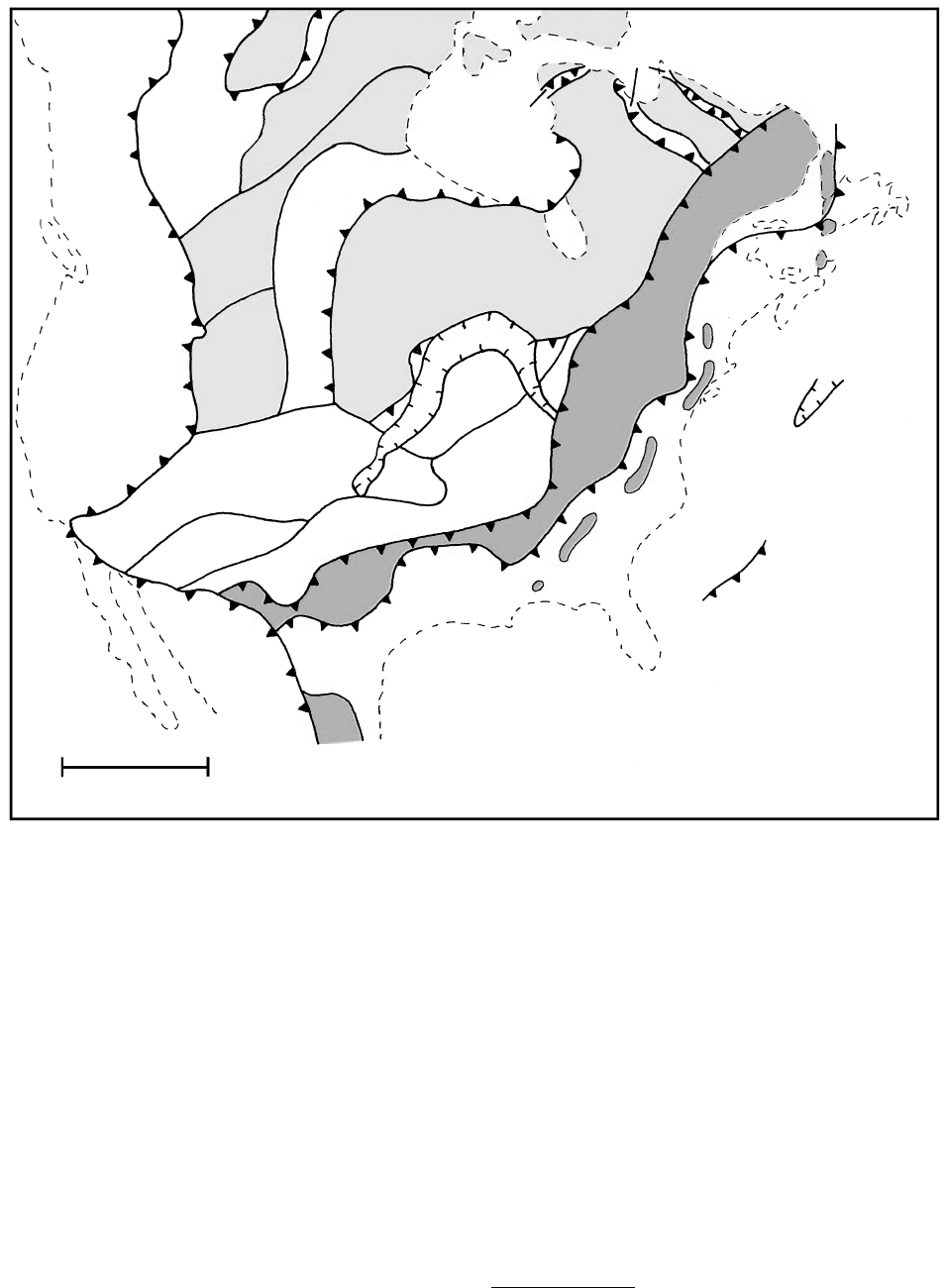
Boundary of accreted Andean-type
arc terrane or continent–continent
collision; teeth on terrane added
to older craton
0 800
0 500
km
miles
1920–1790 Ma
Rae
Superior
Slave
Rae
1980–1840 Ma
Hearne
Wyoming
1790–1690 Ma
1710–1620
1500–1340 Ma
1900–1790
Grenville
Appalachian
(Pz)
Cordilleran ( Mz)
Keweenawan continental
rift 1100 Ma
1920–1790
later) were emplaced in the northeastern part of the
orogen and into adjacent Labrador during three pulses
from 1650 to 1270 Ma. But a voluminous burst of in-
trusions occurred at 1170–1080 in an interior (central)
magmatic belt (Figure 19.28) during periods of crustal
extension between contractional pulses.
19.5.2 Massif-Type Anorthosite
Massifs of anorthosite and kindred rocks were em-
placed into shallow- to moderate-depth crustal meta-
morphic rocks during the middle Proterozoic. They
have been found on every continent except Green-
land and Australia (Ashwal, 1993, Fig. 3.1) but their
largest concentration occurs in eastern North America
(Figure 19.28). Nearly all have been deformed and re-
crystallized to some degree, erasing primary magmatic
features and hindering accurate interpretations. None-
theless, most appear to be basin- or dome-like sheets a
few kilometers thick and as much as thousands of km
2
in area. Least deformed massifs appear to be composite
plutons that consist of many separate intrusions (Fig-
ure 19.30). Some have features transitional to layered
differentiated mafic intrusions, such as the Skaergaard
(Figures 7.45, 12.19, and 12.20).
Anorthosite Suite. Anorthosite is generally the prin-
cipal rock type in massifs but there are also variable
amounts of leucogabbro, leuconorite, and leucotroctolite
Precambrian Rock Associations
637
19.27 Laurentia Craton made of amalgamated Archean and early Proterozoic terranes (ages in Ma). Archean terranes (2.5 Ga; shaded)
include Slave, Rae, Hearne, Wyoming, and Superior. The Grenville Orogen (dark shaded) was sutured onto the southeast margin of
Laurentia from about 1.7 to 1.2 Ga by arc accretion and continent–continent collision. Later, during the Paleozoic, the Appalachian
Orogen was formed of the reworked southeastern side of the Grenville orogen (note dark shaded outliers) and of newly accreted crust.
The Cordilleran Orogen was added to the western side of Laurentia and Grenvillia (in Mexico) during the late Paleozoic and Mesozoic.
Dashed line is present coastline of North America. Redrawn from Rivers (1997).
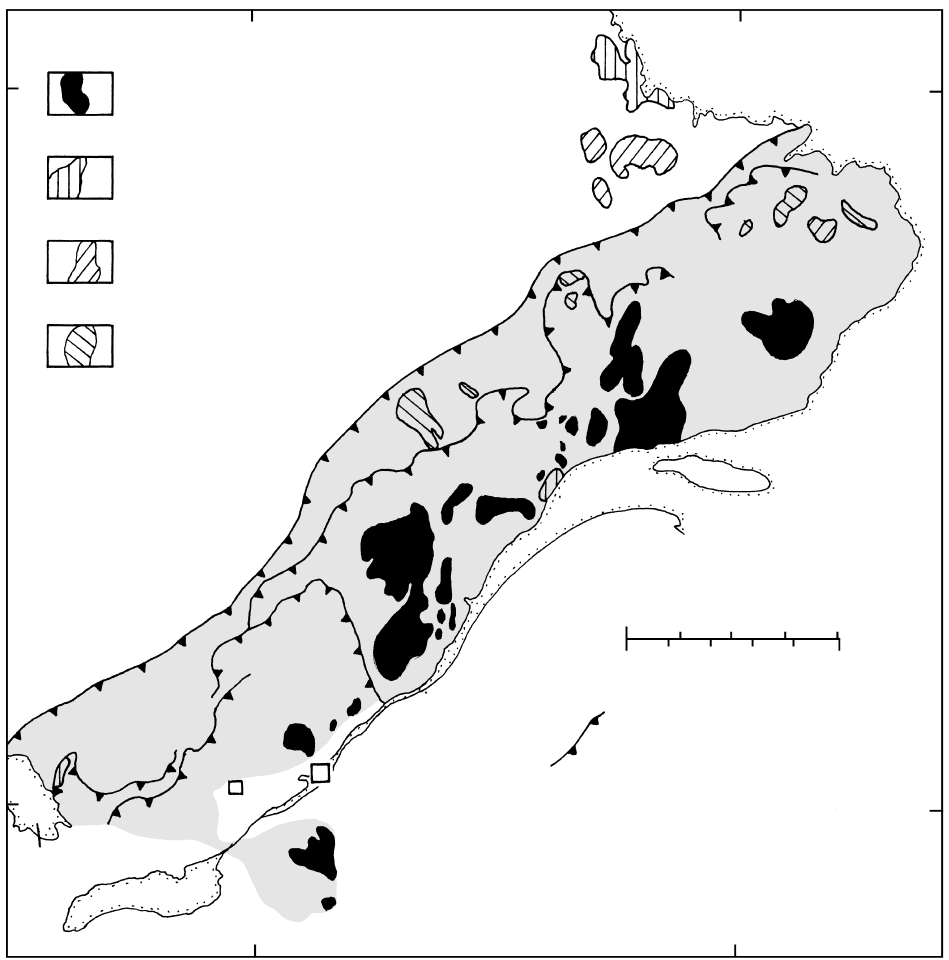
Anorthosite-suite massifs
1170–1040 Ma
1365–1270 Ma
Nain
1320–1270
Atlantic
55°N
45°C
60°W
Shear zone;
ornament on
overriding plate
E
1500–1420 Ma
1645–1620 Ma
Georgian Bay
Lake Ontario
75°W
Marcy
1135–1115 Ma
Montreal
Ottawa
Morin
1155
Grenville
Lac St.
Jean
1160–
1142
E
Front
Ocean
0 km 400
0 miles 250
19.28 Massifs of the anorthosite suite in the northeastern Grenville Orogen of eastern Canada (shaded). The Grenville Front is the northwest-
ern-most mylonitic shear zone of ductile thrusting where high-grade metamorphic rocks were pushed from the southeast onto the mar-
gin of the Laurentian Craton. Rocks between the front and the next shear zone to the southeast are related to those in Laurentia but have
a Grenvillian tectonic and metamorphic overprint. An enlarged map of the southern part is Figure 19.29. Redrawn from Hoffman (1989)
and Rivers (1997). E, eclogite locality (Indares, 1993).
(Figure 2.10a) that have 10–35% mafic minerals as well
as more mafic gabbro, norite, troctolite, and minor
rocks that contain abundant Fe–Ti oxides. Altogether,
these associated comagmatic rock types constitute an
anorthosite suite (Table 19.3 and Figure 19.31). In
many locales, the concentrations of ilmenite and mag-
netite are sufficient to create ore deposits; the largest
Ti deposits in the world are associated with anorthosite
massifs. Possible complementary and cogenetic ultra-
mafic rocks are rarely exposed and geophysical data
in the form of negative gravity anomalies suggest no
large ultramafic mass directly underlies massifs.
Overprinting cataclasis (Figure 8.7) and recry-
stallization are widespread in the anorthosite suite,
obscuring primary fabrics and generally reducing grain
size. Where metamorphic overprints are minimal,
vestiges of magmatic fabric resemble that of many
gabbroic rocks. In leucogabbros, ophitic texture is
638 Igneous and Metamorphic Petrology
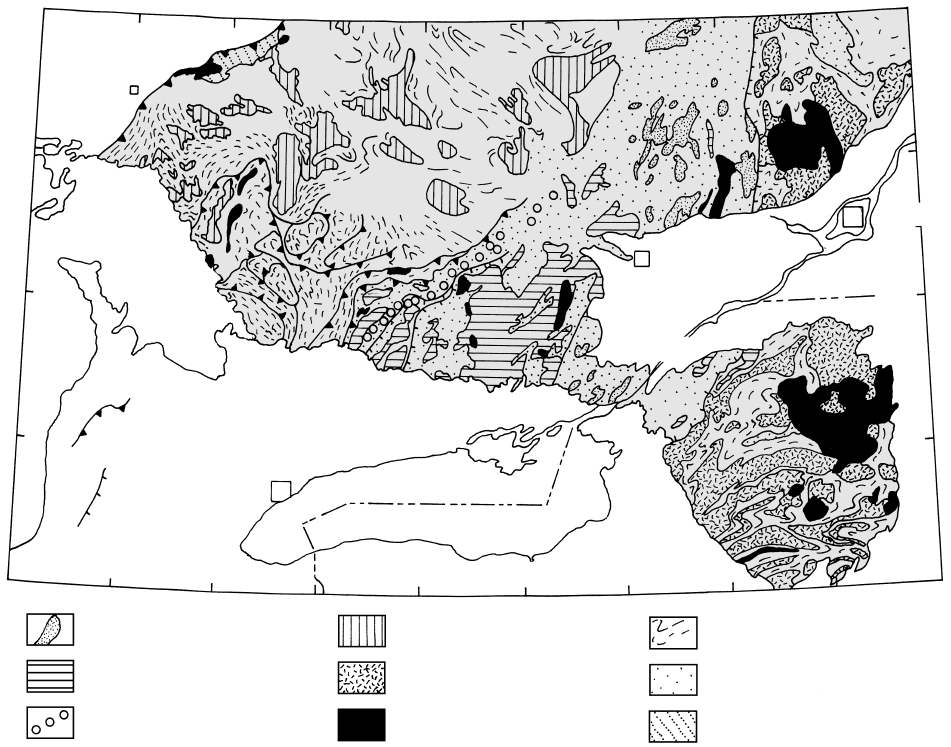
common. Plagioclase crystals range in size from 1 to
10 cm but locally are 1 m or more across. Unlike equant
megacrysts in Archean anorthosites, plagioclases in
Proterozoic anorthosite massifs have typical tabular
habit, which allows expression of igneous lamination.
Various forms of layering and cumulate textures (Fig-
ure 12.16) found in differentiated mafic intrusions are
less common.
Plagioclase compositions in massifs as a whole
generally range between An
40
and An
65
(andesine to
labradorite), in contrast to the bytownite of Archean
anorthosites and labradorite–bytownite of layered
mafic intrusions. In massifs, more calcic plagioclases
are associated with olivine and the more sodic with
orthopyroxene. The content of An in plagioclases is
generally uniform within a particular intrusion; normal
and oscillatory zoning in individual crystals is unusual
whereas reverse zoning is more common.
Plagioclases typically contain different kinds of in-
clusions that formed by exsolution during slow cooling
from initially homogeneous crystals. Relatively sodic
plagioclases are antiperthites that contain exsolved
blebs and lamellae of K-rich feldspar formed from
initially K-rich plagioclase. Inclusions of very fine
(1 micron) Fe–Ti oxides are responsible for black
and shades of gray, blue, and red coloration. Particularly
characteristic of massif-type anorthosites are iridescent
(“labradorescent” or “schillar”) plagioclases produced
by optical interference from regularly spaced, very fine
exsolution lamellae in the composition range between
Precambrian Rock Associations
639
Metamorphosed syenite,
mostly 1200–1100 Ma
Metamorphosed 1700–1400 Ma
granitoids
Ortho- and paragneiss
Quartzite, marble,
paragneiss
2700 Ma paragneiss
Charnockitic suite
Metamorphosed anorthosite,
minor gabbro
Metamorphosed 1300–1100 Ma
granitoids and felsic-mafic
volcanic rocks
Metamorphosed 1090–1050 Ma
nepheline syenite
81°W
79°
77°
75°
Extensional
shear zone
Toronto
Lake
Ontario
Ontario
New York
44°
45°
Montreal
Ottawa
Quebec
New York
St. Lawrence
River
Frontenac
terrane
Elzevir terrane
Contractional
shear zone
Bay
Georgian
45°N
44°
Huron
Lake
Province
Grenville
Sudbury
Superior
Front
79°
76°
Adirondack
Highland
terrane
19.29 Southern end of Grenville Orogen (shaded) in southern Quebec, Ontario, and New York. Pre-Grenville rocks of the Superior Province
to northwest and younger rocks mainly to the south are unshaded. This northwest–southeast transect across the orogen reveals several
mylonitic ductile shear zones in rocks of mid-crustal depths. Contractional zones mark northwest-directed ductile thrusting and exten-
sional shears mark younger minor crustal stretching. Rocks immediately southeast of the Grenville Front include reworked Superior
Province rocks, such as 2700 Ma paragneiss, that were pushed northwestward onto the foreland. Farther southeast, east of Georgian Bay,
a central zone terrane of gneisses intruded by 1700 and 1400 Ma granitoids was transported northwestward on granulite-facies
mylonite zones. The central zone was subsequently a continental margin against which the Elzevir arc terrane and older crust of the Fron-
tenac terrane were thrust northwestward and accreted probably during the Grenville orogeny. The last metamorphic imprint is about
1100–1000 Ma. Redrawn from Hoffman (1989), in which further details of the orogen are described.
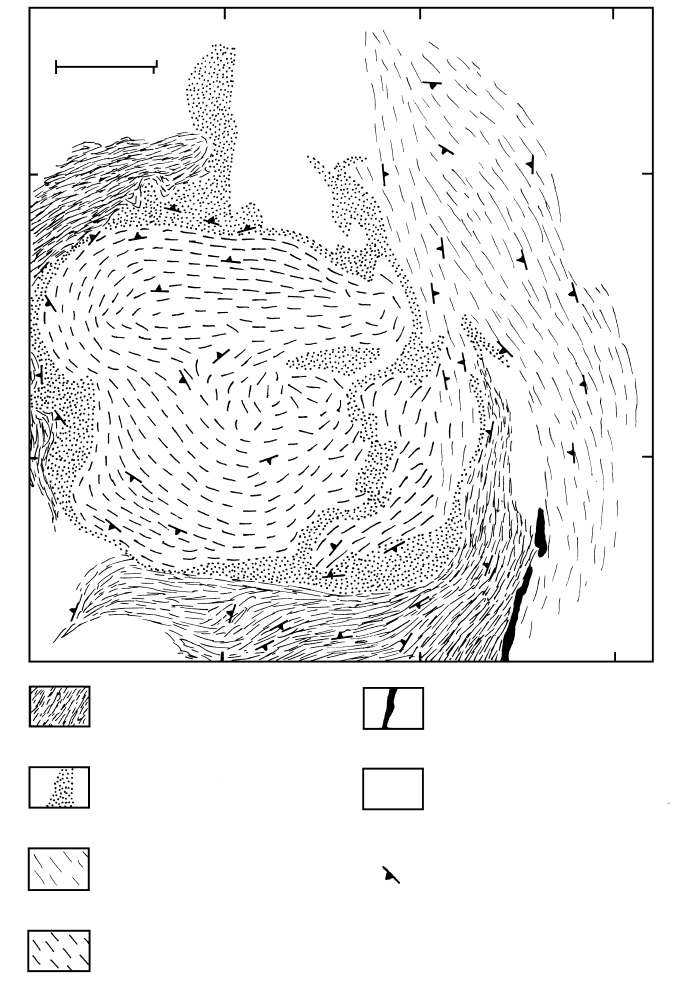
An
56
and An
48
where a narrow solvus exists (not the
same solvus as in Figures 5.18 and 5.21). Metamorphic
recrystallization purges exsolved phases from their
host plagioclase crystals, lightening their color as the
exsolved phase forms discrete separate grains of lower
surface energy. This lightened and green coloration
(Section 19.3.3) and reduction of grain size are useful
field guides to recrystallized parts of massifs.
Typical mafic minerals in massif-type anorthosites
include olivine, (locally occurring as a cumulus phase),
orthopyroxene (typically forming ophitic textures with
major amounts of euhedral to subhedral plagioclases),
and Fe–Ti oxides. A characteristic phase is a high-Mg–
Al orthopyroxene that is typically seen as megacrysts
10–50 cm across but locally to 1 m. The unusually
high concentration of Al
2
O
3
(3–12 wt.%) is harbored
mostly in fine exsolution lamellae of calcic plagioclase.
Most petrologists (e.g. Longhi et al., 1999) believe
these megacrysts crystallized at high pressures in
the lower crustal or upper mantle before they were
640 Igneous and Metamorphic Petrology
Orthopyroxene
granite and monzonite
Ferrogabbro,
ferrodiorite
Recrystallized
anorthosite
Anorthosite
Troctolite
Gneiss country
rock
Strike and dip
direction of
foliation
0km 10
0 miles 6
74°15′ 74°00′ 73°45′
46°15′
46°00′
19.30 Morin Anorthosite Massif, Quebec emplaced at 1155 Ma. For location see Figure 19.28. Field relations clearly indicate that anorthosite
is the oldest magmatic rock and orthopyroxene granite and monzonite the youngest (Emslie, 1975). All rocks are deformed and recrys-
tallized; this overprint is especially strong in the eastern anorthosite lobe. Redrawn from Martignole (1974).
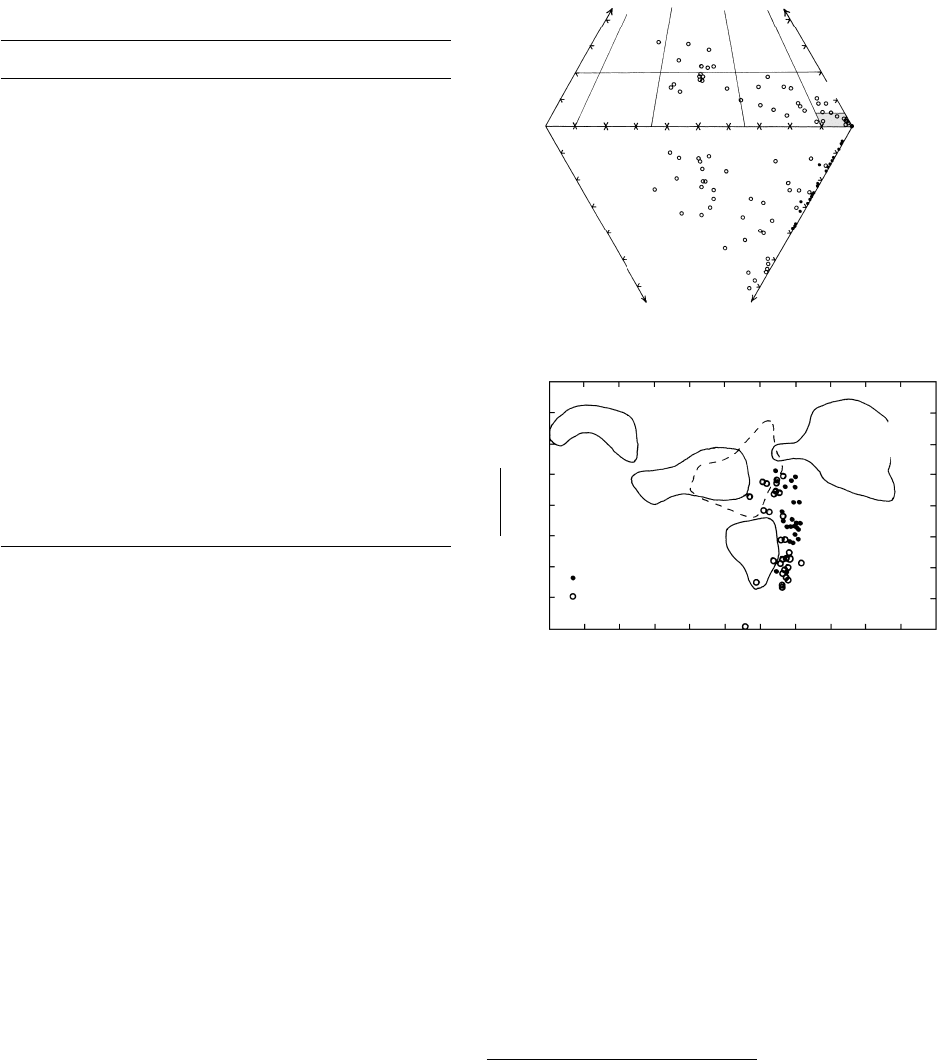
introduced into the shallower crust where the exsolution
occurred and the anorthosite magma finally solidified.
Dark green, brown, or red A-type rocks of the
charnockitic suite (Sections 13.9 and 15.2.5) are
commonly spatially and temporally associated with
anorthosite massifs. Whether they are comagmatic has
been controversial. Close relation in space and time
is necessary but not sufficient evidence for a genetic
relationship. Because charnockitic magmas were nearly
always intrusive into anorthosite (seldom the reverse)
and because of their higher Fe/(Fe Mg) in bulk rock
and mafic mineral compositions, some petrologists
have interpreted them to be evolved residual mag-
mas from parental magma of anorthosite composition.
However, charnockitic rocks tend to lie off the
anorthosite-suite variation trend (Figure 19.31b), cast-
ing doubt on the hypothesized genetic relation. More-
over, charnockitic rocks do not always show depletion
in Eu as expected if the magmas were derived by frac-
tionation of the magma from which anorthosite cry-
stallized (Figure 19.32). Charnockitic rocks also have
higher large-ion-lithophile-element concentrations and
higher initial Sr isotope ratios and lower Nd ratios than
anorthosite, suggesting that they were derived from
crustal partial melts, in contrast to anorthositic magmas
that have a dominant mantle component. The mantle-
derived anorthositic magmas conceivably supplied the
heat necessary for the partial melting of the lower con-
tinental crust that generated the charnockitic magmas.
Origin of the Anorthosite Suite. A variety of petro-
genic models have been advocated for massifs of
anorthosite. In one proposal, espoused as late as the
1970s, large masses of calcic plagioclase were thought
to be created by large-scale metasomatic transforma-
tion of interbedded Al-rich shales and Ca-rich gypsum
or anhydrite evaporites. However, very slow rates of
atomic diffusion make this model untenable. The
magmatic origin of anorthosite is incontestable for the
following reasons:
1. Pyroxene geothermometry indicates magmatic
temperatures.
Precambrian Rock Associations
641
Table 19.3. Chemical Compositions of Rocks from
the Morin Massif-Type Anorthosite Suite
123
SiO
2
54.33 52.66 46.96
TiO
2
0.26 1.30 3.07
Al
2
O
3
26.56 22.09 15.88
Fe
2
O
3
0.51 2.21 6.21
FeO 1.09 3.46 8.65
MnO 0.02 0.06 0.22
MgO 0.92 2.8 3.37
CaO 9.97 9.72 9.97
Na
2
O 4.71 4.17 3.01
K
2
O 0.74 0.75 0.86
P
2
O
5
0.04 0.08 1.03
LOI 1.24 1.16 1.52
total 100.59 100.91 100.75
Fe/(Fe + Mg) 0.485 0.522 0.703
% Normative
feldspar 93 79 58
Ab 42.7 44.6 44.0
An 52.6 49.8 47.2
Or 4.7 5.6 8.8
1. Average of 14 anorthosites.
2. Average of 15 leucogabbros.
3. Average of four ferrogabbros.
Data from Ashwal (1993) and Papezik (1965).
Alkali
feldspar
Plagioclase
Quartz Quartz
Qtz
Diorite
Pyroxene, Fe–Ti oxides
and other mafic minerals
19.31 Composition of anorthosite-suite rock types in the Morin
Massif, Quebec. (a) Modal composition of charnockitic suite
rocks (open circles) and anorthosite, leucogabbro, gabbro,
and norite (small filled circles). Redrawn from Emslie (1975).
Dividing lines from Figure 2.8. Shaded area at plagioclase
apex is field of diorite, gabbro and anorthosite. (b) Chemical
composition; significant modification by metamorphism is
possible. Redrawn from Ashwal (1993). Only a crude evolu-
tionary trend from anorthosite to leucogabbro to ferrogabbro
(ferrodiorite) to Fe–Ti-oxide-rich rocks is evident. Charnockitic
rocks lie well off this trend.
Fe
(Fe Mg)
1.0
0.8
0.6
0.4
0.2
SiO
2
(wt.%)
Silicic
charnockitic
rocks
Ferrodiorite
Fe–Ti-oxide-rich
rocks
Ferrogabbro
Gabbro,
norite
MORIN
MASSIF
20 30 40 50 60 70
Anorthosite
Leucogabbro, leuconorite
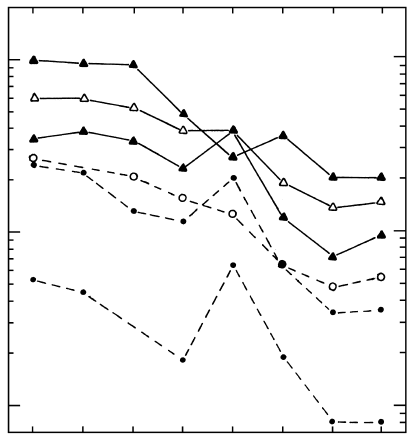
2. Fabrics, such as ophitic texture, are consistent with
crystallization from a melt.
3. Positive Eu and Sr anomalies in trace element pat-
terns (Figure 19.32) are consistent with substitution
of Eu and Sr for Ca in plagioclases crystallizing
from mafic magmas.
4. Field relations, Fe/(Fe Mg) ratios, and plagio-
clase compositions (Table 19.3) indicate that the
commonly associated sequence (Figures 19.30 and
19.31) of anorthosite, leucogabbro, ferrogabbro,
and Fe–Ti-oxide rock formed through crystal-melt
fractionation. (Nonetheless, not all ferrogabbroic
rocks, including commonly associated ferrodior-
ites, show a negative Eu anomaly complementary to
the positive anomaly in anorthosite, suggesting the
Fe-rich rocks are polygenetic.)
5. Isotopic data indicate variable amounts of a mantle
component.
But the exact nature of the parental magma of
massif-type anorthosites has been a long-standing
controversy. If basaltic, it must have been capable of
crystallizing large amounts of andesine–labradorite and
only minor amounts of mafic minerals, mostly orthopy-
roxene and lesser local olivine. Because of the relatively
high Fe/(Fe Mg) 0.4 in anorthosite suite rocks
(Figure 19.31b), the parent magmas were more evolved
than typical primitive basalt magmas. That anorthosites
are cumulates is compatible with the virtual absence of
glassy or aphanitic rocks of anorthositic composition
and with the relatively uncommon occurrence of
anorthosite dikes. Hence, magmas of anorthosite com-
position probably do not exist. The cumulate heritage
is supported by transitional occurrences and resem-
blances with differentiated layered basaltic intrusions
(Section 12.4.2; see also Ashwal, 1993). But was this
parent basaltic magma unusually enriched in plagioclase
components, as fine-grained “quenched” margins around
leucogabbro on some massifs suggest, or was it a nor-
mal tholeiitic basalt magma from which plagioclases
accumulated? The cumulate origin, espoused by N. L.
Bowen as early as 1917, raises three major questions:
1. Where are the complementary pyroxene–olivine
fractionates?
2. How was this ultramafic fraction so effectively sep-
arated from plagioclase?
3. If anorthosite massifs were created by plagioclase
fractionation and accumulation, why are they re-
stricted to the middle Proterozoic?
The first two questions are addressed in the model
depicted in Figure 19.33 that follows the view of
Bowen (1917), as further developed by Emslie (1978)
and Ashwal (1993), among others. In this model,
mantle-derived basaltic or picritic magmas are buoy-
antly blocked at and underplate the continental crust.
Crystallizing olivines and pyroxenes sink, forming ul-
tramafic cumulates which become part of the mantle.
The residual melt becomes enriched in Al, Ca, Na, and
LILE, while Fe/Mg is increased. Crystals of labradorite–
andesine precipitate, which float to the top of the
magma chambers in a suspension of Fe–Al-rich re-
sidual melt. High P not only stabilizes aluminous
orthopyroxenes, some of which are entrapped in the
rising mat of buoyant plagioclase, but also allows
crystallization of more sodic plagioclases that are
significantly less dense than the melt (Sections 8.3.3
and 16.4.2). High temperatures in the magma and its
slow cooling allow growth of large crystals. Heat from
the crystallizing magma promotes partial melting of the
overlying sialic crustal rocks, producing charnockitic
magmas. The accumulated layer of floated plagioclases
becomes gravitationally unstable beneath slightly denser
crustal rock and rises as buoyant diapirs, like those of
granitic magma shown in Figure 9.15. Coalescence of
multiple diapirs in the upper to middle crust forms
composite anorthosite massifs.
Isotopic data (Emslie et al., 1994; Scoates and Frost,
1996) as well as crystal-melt equilibria constraints
642 Igneous and Metamorphic Petrology
Rock/primitive mantle
100
10
1
La
ANORTHOSITE
Margin
Mafic
Margin
Quartz-rich
ORTHOPYROXENE
MONZONITE
Ce Nd Sm Eu Tb Yb Lu
19.32 Representative primitive mantle-normalized rare-earth-element
patterns for anorthosite (dashed lines) and charnockitic ortho-
pyroxene monzonite in the Marcy Massif, Adirondack
Mountains, New York (location in Figure 19.28). Data from
Seifert et al. (1977). Anorthosites have variable concentra-
tions of REE and strong positive Eu anomalies except for one
leucogabbro near the margin of the massif (open circles).
Charnockitic rocks that intrude anorthosite are more REE
enriched. Quartz-rich sample has a negative anomaly, mafic
sample has a positive Eu anomaly, and a sample from the
margin of the intrusion (open triangles) has little anomaly; this
pattern is consistent with the charnockitic magma differentiat-
ing internally and independent of any genetic relation to the
anorthosite magma.
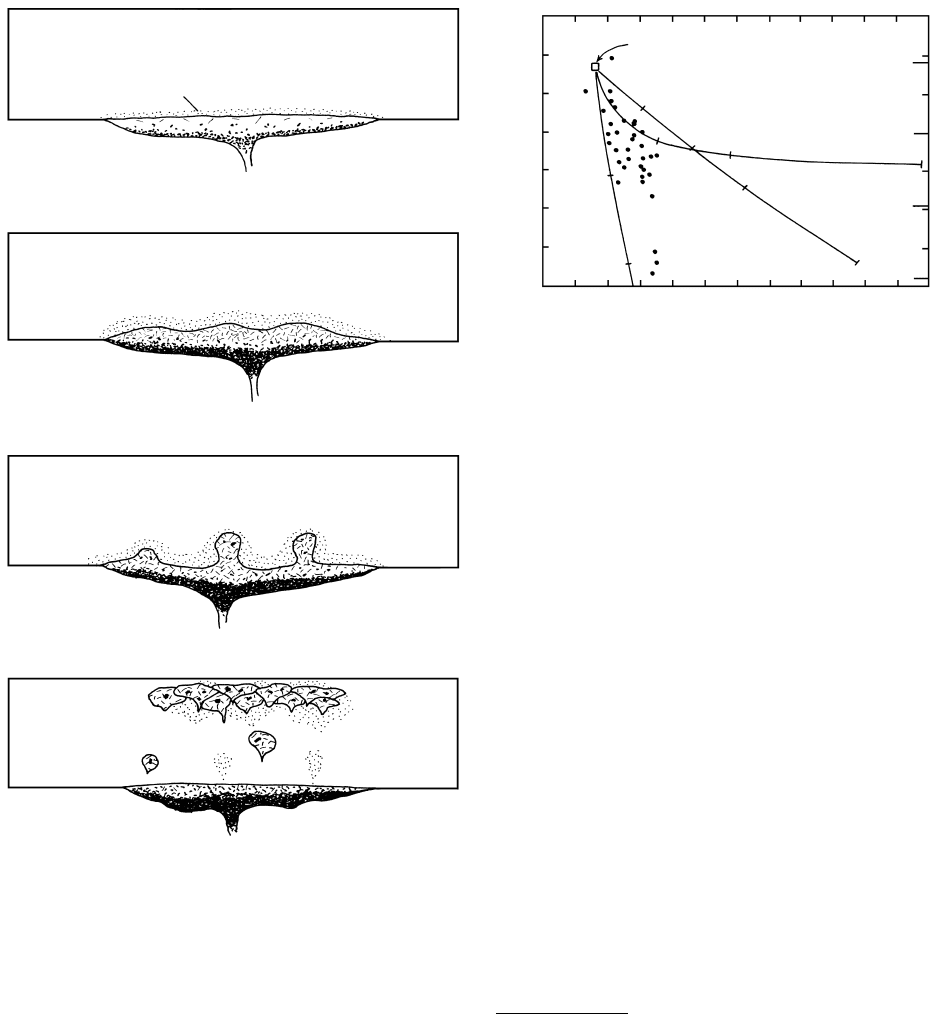
(Longhi et al., 1999) and field relations (Dempster
et al., 1999) indicate variable amounts of contamination
of primitive mantle-derived mafic magmas by con-
tinental crustal components (Figure 19.34). Chemical
variation diagrams, such as Figure 19.31b, that depict
considerable scatter in rock compositions are difficult
to reconcile with simple closed-system differentiation
processes in the evolution of anorthosite suites. Meta-
morphic overprints could, of course, contribute to the
scatter.
Petrologists for well over a century (see historical
summary in Bowen, 1928, p. 208) have noted that
contamination of mafic magma by aluminous rock can
suppress crystallization of clinopyroxene while enhan-
cing formation of plagioclase and orthopyroxene. This
is the very attribute of anorthosite suites that has made
recognition of parent magmas so problematic. The
contamination reaction, expressed in terms of end-
member mineral components, is
Al
2
SiO
5
CaMgSi
2
O
6
→
pelitic clinopyroxene
contaminant in magma
CaAl
2
Si
2
O
8
MgSiO
3
plagioclase orthopyroxene
in magma in magma
The possible role of immiscible melts in produc-
tion of complementary silicic and Fe–Ti-rich melts
associated with anorthosite magmas has yet to be fully
understood (Loferski and Arculus, 1993).
Tectonic Setting. The third question posed above has
not been satisfactorily resolved. If creation of massif-
type anorthosite is indeed linked to ponding of basaltic
magmas near the continental Moho, then several mod-
ern tectonic settings are possible. One that has been re-
peatedly suggested is the continental rift where A-type
granites are common. A possible analog of Proterozoic
anorthosite massifs is the 1200-km-long Silurian–
Jurassic Nigeria–Niger belt of anorogenic ring com-
plexes (Figure 13.35) where anorthosite is associated
with A-type felsic rocks (Demaiffe et al., 1991). More
anorthosite might exist beneath the present level of
erosion in the Niger association that, interestingly,
is also long-lived (250 My) like the eastern North
America association (500 My). However, not all
Precambrian Rock Associations
643
Silicic partial
melt
Continental
crust
Mantle
(a) Basaltic magma underplates
crust; mafic crystals sink,
plagioclase floats
(b) As magma continues to
crystallize, instabilities develop
in mass of floated plagioclase
(c) Plagioclase-rich
diapirs begin to rise
(d) Ascended diapirs
coalesce into anorthosite
massif; ultramafic cumulates become part of mantle
19.33 Conceptual model for evolution of Proterozoic anorthosite
massifs. Redrawn from Ashwal (1993).
ε
Nd
⫺2
5
10
⫺4
0
2
5
25
10
15
25
0.5124
0.5125
0.5126
0.5127
143
Nd/
144
Nd
50
100
0.7140.7120.7100.7080.7060.7040.702
High-Al basalt
parent magma
Proterozoic
granitoids
Archean
gneiss
Archean
metashale
87
Sr/
86
Sr
19.34 Isotope ratios of anorthositic rocks (filled circles) from the
Laramie Anorthosite Complex, Wyoming, and possible parent
magma and crustal contaminants. Tick marks on contaminant
curves labeled 5, 10, 15, and so on indicate percent of con-
taminant assimilated into parent high-Al basalt parent magma.
Small amounts of assimilated Archean metamorphosed shale
and granitic gneiss that have
87
Sr/
86
Sr 0.75331 and 0.76597
and
Nd
16.2 and 16.3, respectively, are capable of
generating the array of isotope ratios in the anorthositic rocks.
Redrawn from Scoates and Frost (1996).
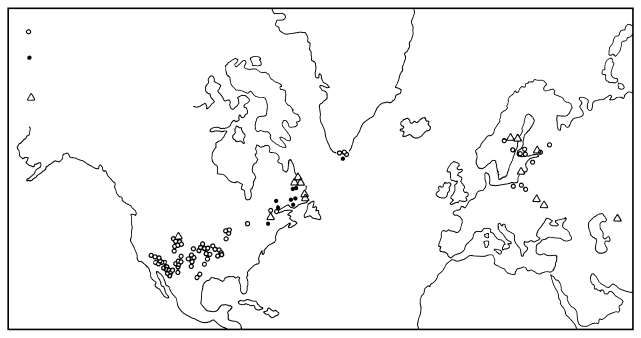
geologists are willing to believe the Nigeria–Niger belt
is a rift structure. The notion discussed above that the
Grenvillian orogen, where most anorthosite massifs
are lodged, began to evolve during Andean-type plate
convergence and concluded with Himalayan-type
continent–continent collision provides the opportun-
ity for potential rifts during episodes of late orogenic
extensional collapse (Rivers, 1997). In both of these
Cenozoic orogenic systems, thickened crust has experi-
enced spatially and temporally localized episodes of
extension and rifting.
In another model, the apparent absence of anor-
thosite massifs before 1600 Ma and since 1100 Ma
was a result of unfavorable tectonothermal conditions.
The Laurentian continent that was assembled about
2000–1800 Ma (Figure 19.27) is envisaged by Hoffman
(1988) to provide a unique situation during the history
of the Earth. This continent was the first of sufficient
size to act as an insulating thermal blanket, reducing
heat loss from the underlying mantle, and promoting a
massive upwelling of mantle that produced a copious
cascade of basaltic magmas underplating the base of
the continent to generate anorthosite massifs. This pos-
tulated upwelling must have had a wall-like configura-
tion thousands of kilometers long, about an order
of magnitude larger than the diameter of cylindrical
modern mantle plumes beneath Hawaii and Iceland
(Figure 13.6). Since the massif–anorthosite event,
Hoffman (1988) believes the mantle cooled sufficiently
to preclude recurrence of this unique thermal anomaly.
19.5.3 Rapakivi Granites
The unusual and classic rapakivi granites of southern
Finland have been recognized for three centuries.
Similar rocks are now known elsewhere, mostly in the
Baltic Shield, in southern Greenland, and in a belt
extending southwesterly from Labrador through mid-
continent to the southwestern USA (Figure 19.35).
These granites, also including notable occurrences in
Brazil and Venezuela, are middle Proterozoic, from
1800 to 1100 Ma. Younger and older rapakivi granites
are widely scattered and of minor volume, according to
Haapala and Rämö (1999). These Finnish petrologists,
whose summary is reviewed below, define rapakivi
granites as “A-type granites [Section 13.9] character-
ized by the presence, at least in the larger batholiths,
of granite varieties showing the rapakivi texture.”
Rapakivi granites share compositional features with
Cenozoic topaz granites and rhyolites in bimodal asso-
ciations with basaltic rocks.
At least two explanations have been proposed for
the origin of rapakivi texture in which K-rich alkali
feldspars are mantled by sodic plagioclase (Figure
7.18). Wark and Stimac (1992) propose mixing of sili-
cic and more mafic magmas so that alkali feldspar
phenocrysts crystallized in the former are rimmed by
plagioclase components from the latter. Nekvasil
(1991), on the other hand, proposes an ascending,
decompressing, closed magma system that stabilizes
plagioclase at the expense of alkali feldspar. Figure 5.25
shows that a model granite magma system at, say, P
5 kbar in which quartz albite K-feldspar are in
equilibrium with melt at a ternary invariant point will,
as it decompresses to lower P, experience a shift in
phase equilibria. The system is stranded in the stability
field of albite melt so albite precipitates on unstable,
resorbing K-feldspar; unstable quartz also dissolves into
the melt. Eklund and Shebanov (1999) find evidence
for this scenario in Proterozoic rapakivi batholiths
in the Fennoscandian Craton. They extend the defini-
tion of rapakivi fabric to include not only plagioclase-
mantled anhedral alkali feldspars but anhedral quartz
and euhedral plagioclase megacrysts as well. Mineral
inclusions in the partially resorbed quartz and alkali
feldspars indicate equilibration at 5–6 kbar whereas
inclusions in the plagioclase rims indicate growth at
644 Igneous and Metamorphic Petrology
Mostly rapakivi granite
Mostly anorthositic
suite rocks
Rapakivi and
anorthositic suite
1500–1000 Ma
1600–1200 Ma
1600–1500 Ma1600–1500 Ma
1800 Ma
1750 Ma
19.35 Distribution of Proterozoic rapakivi granites and anorthositic suite rocks. Redrawn from Haapala and Rämö (1999). Compare
Figure 19.28.
1–3.5 kbar. Evidence for a decompression origin of
rapakivi texture is better preserved in shallower plu-
tons than in larger, deep crustal, more slowly cooled
intrusions.
The prominent belt of rapakivi granites in northern
Europe and across North America coincides broadly in
age and eclipses the geographic belt of massif-type
anorthosite suite (Figures 19.28 and 19.35). Hence,
any model explaining the origin of the former must
somehow account for the latter, even though the two
may not be strictly co-magmatic. The two might at least
share a similar tectonic setting.
Though by no means certain, an incipient or
aborted continental rift has been suggested because
this is the tectonic setting of Phanerozoic A-type gran-
ites. Indeed, extensional tectonic features have been
recognized in some of the Finish Proterozoic rapakivi
occurrences. A preferred model (Frost and Frost,
1997; Haapala and Rämö, 1999) for the origin of
the essentially bimodal mafic–silicic magmas of the
anorthosite–granite association involves underplating
of continental crust by mantle-derived tholeiitic basalt
magmas. Expelled heat generates granitic partial melts
from sialic country rocks. However, the lack of negat-
ive Nb anomalies in most rapakivi and A-type granites
precludes much crustal contribution. This suggests
that, especially for the more reduced rapakivi magmas,
derivation was by extreme differentiation of the tholei-
itic intrusions or partial melting of them generated by
heat from subsequent and continuing underplating
(Section 13.9.2).
U–Pb chronologic data show that the three-step
westward growth of the Proterozoic Baltic Shield in
southwestern Sweden by arc magmatism was “echoed”
by three slightly younger episodes of also westward mi-
grating intracratonic rapakivi magmatism in southeast-
ern Sweden (Åhäll et al., 2000). How these contrasting
styles of magmatism might be linked in the convecting
mantle is speculative. Indeed, how magmatism in the
8000-km-long belt of 1800–1100 Ma rapakivi granites
and largely coeval anorthositic rocks is linked to man-
tle dynamics is a major unresolved question.
19.6 GRANULITE-FACIES TERRANES
IN ARCHEAN AND PROTEROZOIC
CRATONS
Although Phanerozoic granulite-facies rocks do exist,
such as the famous Hercynian granulites of Europe
formed at about 300 Ma, the majority of these high-
grade metamorphic rocks occur in Precambrian cra-
tons (Harley, 1989). In some places, there is a regular
and continuous prograde zonation from amphibolite-
facies rocks into granulite but more typically a terrane
of wholly granulite-facies rocks is separated from un-
like rocks by an unconformity, post-metamorphic fault,
or shear zone. Some wholly granulite terranes were
metamorphosed at constant P but variable T, whereas
others are the reverse. Many granulite terranes show
partial to complete retrogression to amphibolite- or
greenschist-facies assemblages, particularly along faults
and shear zones where water infiltrated. Granulite
protoliths are compositionally diverse sedimentary
and magmatic rocks. Polymetamorphism is typical.
Charnockitic rocks (Section 15.2.5) are widespread.
Many granulite terranes have a subhorizontal planar
fabric expressed by compositional layering that has
been locally isoclinally folded and transposed into root-
less folds (Figure 14.19b). This fabric is consistent with
large amounts of vertical flattening and subhorizontal
extension.
For brevity in this section, granulite-facies rocks and
terranes will simply be referred to as granulites. This
usage does not connote a particular fabric, as in the
older geologic literature.
19.6.1 Mineral Assemblages and Reactions
The transition from hydrous amphibolite-facies to mostly
anhydrous granulite assemblages (Sections 18.3.1 and
18.3.5) is marked by formation of orthopyroxene
alkali feldspar at the expense of biotite in pelitic and
felsic rocks and of orthopyroxene clinopyroxene (
almandine–pyrope garnet quartz) from hornblende
in more mafic rocks. Mineral assemblages and thermo-
barometry indicate granulite assemblages equilibrate
over a broad range of temperatures generally from
about 650 to 900°C but to as much as 1050°C and
pressures of generally 5 kbar to as much as 12 kbar
or depths of 20–45 km (Harley, 1989, 1998). Lower
pressures are the same as those at which amphibolite-
facies assemblages equilibrate but temperatures are
higher and water activity is lower. At one time it was
thought that the only difference in equilibrating con-
dition was the lower water activity. Possible factors
lowering water activity include extraction of water
from the prograding system via dehydration reactions,
extraction of hydrous partial melts, or transfer of water
down a concentration gradient into adjacent dry mafic
magmas. Another factor in the conversion could be
infiltration of CO
2
into the amphibolite system, dilut-
ing the water concentration and destabilizing hydrous
phases. That this can actually happen is vividly shown
in outcrops in southern India where light-colored
amphibole–feldspar orthogneiss has been converted
into dark pyroxene charnockite in folds and tension
fractures related to overprinting shear deformation
( Janardhan et al., 1982). Fluid inclusions in the
charnockite are dominantly CO
2
whereas those in the
amphibole gneiss are dominantly H
2
O. Beginning
with Touret in 1971 (see Touret and Hartel, 1988), this
contrast in fluid inclusion composition between
Precambrian Rock Associations
645

amphibolite- and granulite-facies assemblages has been
found to be a general phenomenon. The CO
2
is specu-
lated to have come from the upper mantle, perhaps via
exsolution from crystallizing underplating basaltic
magmas. However, fracture-controlled infiltration of
CO
2
to create an anhydrous mineral assemblage from
amphibolite is likely to be only local and not a wide-
spread, pervasive terrane-forming process because
CO
2
-rich fluids cannot migrate along grain boundaries
(Section 11.2.2).
There has been a persistent debate during the late
decades of the twentieth century, made more complic-
ated by the CO
2
issue, whether granulites in general
represent the crystalline residua remaining after extrac-
tion of granitic partial melts (Section 11.6; see also
Clemens et al., 1997). Although mineral assemblages of
many granulite-facies rocks satisfy a residual relation-
ship after extraction of granite partial melt, not all
granulites have the expected depletions in LIL and
LREE elements (Vielzeuf et al., 1988).
19.6.2 P T Paths and Tectonic Evolution of
Granulite-Facies Terranes
An additional debate revolves around the tectonic
setting and thermal history of granulites. Partly, the
controversy stems from their widespread occurrence
in Precambrian cratons whose tectonic character is
usually unknown with certainty but also because their
P–T paths that can provide important tectonic con-
straints are difficult to accurately determine and many
published ones are suspect.
Accurate determination of complete P–T paths (Sec-
tion 18.1) in granulites is hindered and usually imposs-
ible because of the relatively rapid rates of diffusion
and, hence, of mineral equilibration at the relatively
high temperatures of the granulite facies (Frost and
Chacko, 1989; Selverstone and Chamberlain, 1990).
Commonly used ion-exchange mineral thermometers
have closure temperatures below those at which granu-
lites equilibrate. Thus, mineral thermobarometry can
provide no information on prograde paths and near-
peak P–T conditions, both of which are overprinted by
subsequent retrograde but still high-T equilibration.
The highest recorded T may not be the peak T of
metamorphism.
More reliable P–T paths can be constructed in some
instances using petrogenetic grids based on mineral
assemblages preserved in undeformed or otherwise
unmodified reaction textures, such as coronas (Figures
16.6 and 16.8) and inclusions in poikiloblasts.
Harley (1989) documented two general categories
of retrograde granulite paths—essentially isothermal
versus isobaric in Figure 19.36—that are presumed to
correspond to contrasting tectonothermal evolution-
ary regimes. The simplest explanation for the nearly
isothermal decompression paths is that they are retro-
grade segments of clockwise P–T paths created in
thickened orogens (Section 18.1). Such orogens com-
monly experience extension late in their evolution,
such as since the Miocene in the Altiplano–Puna in the
central Andes Mountains and Tibet Plateau north of
the Himalaya Mountains. Such extension is consistent
with the subhorizontal planar fabric of many granulite
terranes.
The lack of pronounced decompression in the
nearly isobaric retrograde paths implies that the peak
metamorphism occurred in continental crust of more
or less normal thickness, or at least one in which near
isostatic equilibrium prevailed so that very little sub-
sequent uplift and unroofing took place. As one example,
retrograde corona reaction textures and chronologic
data indicate the Archean Napier Complex, Enderby
Land, in the East Antarctica shield cooled nearly
isobarically after attaining peak 900–1000°C and 8–
10 kbar at 3070 Ma. Independent evidence indicates
the stabilized craton experienced little uplift and ero-
sion for about 2 Gy while cooling only 300–400°C
(Figure 19.36; see also Ellis, 1987), thus precluding
the metamorphism being related to orogenic crustal
thickening.
The nature of the prograde path segment of these
paths has been far more controversial. Is it clockwise or
counter-clockwise and what is the responsible thermo-
tectonic regime? Critics of the clockwise-path option
have pointed out an absence of eclogite relics or of
kyanite inclusions in poikiloblasts that would indicate
a higher P prograde path. However, Selverstone and
Chamberlain (1990) note the existence of kyanite
inclusions in garnets in the Coast Ranges granulite
terrane in British Columbia. Together with other data,
they construct a clockwise path consistent with thermal
relaxation in a thickened orogen. They also argue that
the nearly isobaric retrograde path for this terrane, and
by implication others, calculated from garnet–biotite
and GASP thermobarometry (Section 16.11.3) is a spu-
rious result of high-T mineral homogenization. Advoc-
ates of counter-clockwise prograde paths point to the
existence of low-P andalusite and cordierite, either as
inclusions or relict grains.
Documentation of Counter-Clockwise P T Paths in
T
wo Terranes. The northwestern Superior Province
(Figure 19.8) harbors an unusually complete 20-km-
thick section of the Archean crust in which a zoned
greenschist- to amphibolite-facies terrane continues
without structural break into the Pikwitonei granulite
domain. The lower-grade boundary of the granulite
domain is simply an orthopyroxene isograd. Chrono-
logic data, textural observations, and thermobarometry
on zoned garnets and other phases have been integ-
rated to construct counter-clockwise P–T–t paths
for three parts of the amphibolite–granulite domain
646 Igneous and Metamorphic Petrology
